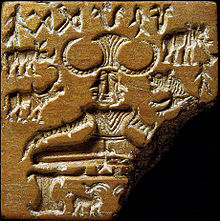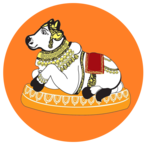Pashupati
| Pashupati | |
|---|---|
|
Lord of the Animals
|
|

The Pashupati seal, showing a seated and possibly ithyphallic figure, surrounded by animals.
|
|
| Affiliation | Incarnation of Shiva |
| Region | India and Nepal |
| Part of a series on |
| Shaivism |
|---|
 |
Pashupati (Sanskrit Paśupati) is an incarnation of the Hindu god Shiva as “lord of the animals”. He is revered by Shaivites throughout the Hindu world, but especially in Nepal, where he is commonly known as Pashupatinath and regarded by Hindus as the national deity.[citation needed]
Etymology
Paśupati “Lord of all animals” was originally an epithet of Rudra in the Vedic period[1] and now is an epithet of Shiva.[2]
The Deity
Pashupatinath is an avatar of Shiva, one of the Hindu Trinity. He is the masculine counterpart of Shakti.
The five faces of Pashupatinath represent various incarnations of Shiva; Sadyojata (also known as Barun), Vamdeva (also known as Uma Maheswara), Tatpurusha, Aghor & Ishana. They face West, North, East, South and Zenith respectively, and represent Hinduism’s five primary elements namely earth, water, air, light and ether.[3]
Puranas describe these faces of Shiva as [3]
| “ | Sadyojata, Vamdeva, Tatpurusha & Aghora are the four faces,The fifth is Ishana, unknowable even to the seers | ” |
Nepal
Pashupatinath Temple, Nepal
Though Nepal is an officially secular state, its population is predominantly Hindu, and Lord Shree Pashupatinath is revered as a national deity. The Pashupatinath Temple, located at the bank of the river Bagmati, is considered as the most sacred place in Nepal. The mythology hold that Lord Pashupatinath started living in Nepal in the form of a deer, then when he saw the Kathmandu Valley and he was overwhelmed by its beauty.
India
A Pashupatinath temple is sited on the banks of the Shivana river in Mandsaur, Madhya Pradesh, India. It is one of the most prominent shrines in Mandsaur, and Lord Shiva in the form of Lord Pashupatinath is its primary deity. Its main attraction is a unique Shiva Linga displaying eight faces of Lord Shiva. The shrine has four doors, representing the cardinal directions.

